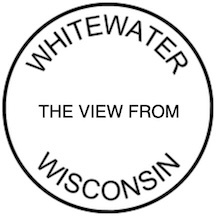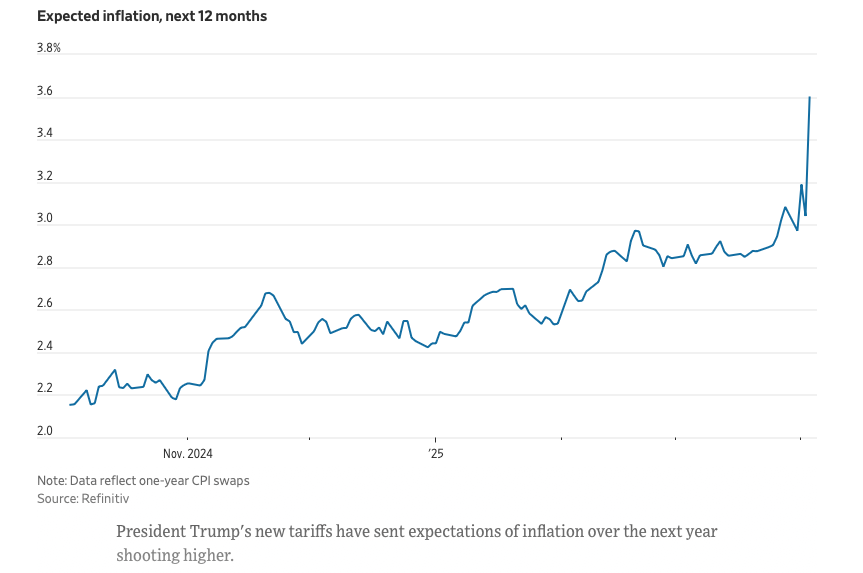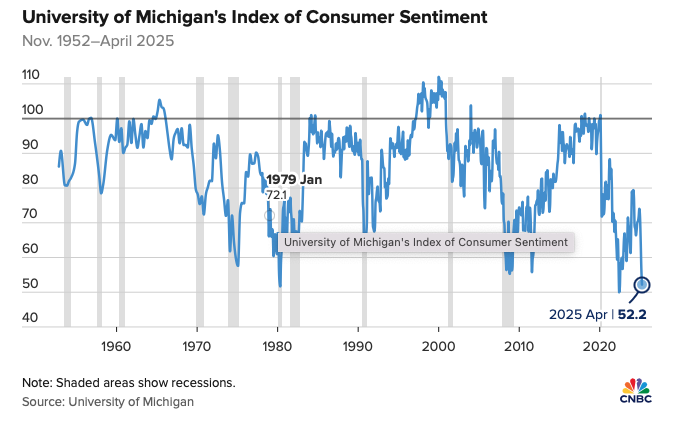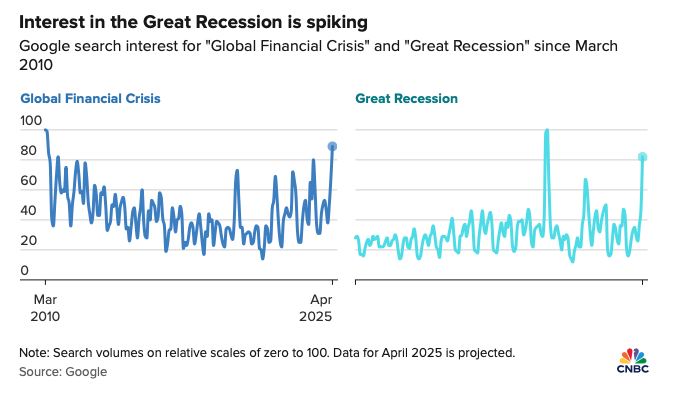Good morning. Wednesday in Whitewater will be windy with a high of 48. Sunrise is 7:17 and sunset is 6:00 for 10 hours 44 minutes of daytime. The moon is a waxing crescent with 1.1 percent of its visible disk illuminated. Whitewater’s Alcohol Licensing Committee meets at 5 PM. On this day in 1962, President…
Special Interests
City, Culture, Daily Bread, Economics, Economy, Entitlement, Reasoning, Special Interests, Speech & Debate
Daily Bread for 10.21.25: On an Application of Newton’s Third Law of Motion to Whitewater, Wisconsin
by JOHN ADAMS •
City, Daily Bread, Economy, Entitlement, Reading, Reasoning, Special Interests
Daily Bread for 10.16.25: Large Language Models and Whitewater (Or You Are What You Put In)
by JOHN ADAMS •
Good morning. Thursday in Whitewater will be mostly sunny with a high of 68. Sunrise is 7:09 and sunset is 6:10 for 11 hours 1 minute of daytime. The moon is a waning crescent with 22.1 percent of its visible disk illuminated. Whitewater’s Community Development Association meets at 5:30 PM. On this day in 1780,…
City, Daily Bread, Special Interests
Daily Bread for 10.13.25: Two Techniques of the Special Interest Men
by JOHN ADAMS •
Good morning. Monday in Whitewater will be cloudy with a high of 68. Sunrise is 7:06 and sunset is 6:15, for 11 hours 9 minutes of daytime. The moon is a waning gibbous with 52.1 percent of its visible disk illuminated. Whitewater’s Plan & Architectural Review Commission meets at 6 PM. On this day in…
City, Daily Bread, Development, Special Interests
Daily Bread for 9.19.25: The Shock of the Normal
by JOHN ADAMS •
Good morning. Friday in Whitewater will be partly cloudy with a high of 81. Sunrise is 6:39 and sunset is 6:57, for 12 hours, 18 minutes of daytime. The moon is a waning crescent with 5 percent of its visible disk illuminated. On this day in 1796, George Washington’s Farewell Address is printed across America as…
America, Babbittry, Boosterism, City, Daily Bread, Economics, Economy, Special Interests, That Which Paved the Way, Trumpism, Willful Ignorance, Wisconsin
Daily Bread for 4.26.25: Consumer Sentiment Falls, and Web Searches for Economic Calamity Rise
by JOHN ADAMS •
Good morning.

Saturday in Whitewater will be sunny with a high of 59. Sunrise is 5:55 and sunset is 7:50, for 13 hours, 54 minutes of daytime. The moon is a waning crescent with 2.2 percent of its visible disk illuminated.
On this day in 1954, the first clinical trials of Jonas Salk‘s polio vaccine begin in Fairfax County, Virginia.
Two charts tell the tale of Americans’ economic concerns:
See Alex Harring, Americans are getting flashbacks to 2008 as tariffs stoke recession fears, CNBC, April 26, 2025.
When sentiment declines, it’s understandable that Americans would look for examples of other difficult times.
For modern Whitewater, the Great Recession’s influence is the key to understanding both economics and politics in the city. It is Whitewater’s signal modern event. Those difficult years from 2007-2009 led to an aftermath that still afflicts the city.
The failure of local officials and community leaders during that time was astonishing: the boosters1 wanted to deflect past others’ suffering, the special-interest men diverted valuable resources to their own schemes while Whitewater stayed poor2, the center-left grew but still struggles to land a decisive blow3, and the rightwing populists4 now in the city owe their present role as a faction to forces they can’t or won’t grasp.
_____
- Narrow of mind and small of heart. See the FREE WHITEWATER category on Boosterism. ↩︎
- Avaricious schemers failing time and again to match the accomplishments of the generation before them. See the FREE WHITEWATER category on Special Interests. ↩︎
- It does no good to talk to a hyena in a soft voice hoping that the vile creature will give up meat for vegetables. See Wisconsin Senate Democrats Hope Hyenas Will Stop Eating Meat. ↩︎
- An authoritarian populist movement of recrimination and revenge. See Defining Populism. ↩︎
Hubble views of Mars and more for space telecope’s 35th anniversary:
Authoritarian Populism, Authoritarianism, City, Daily Bread, Economics, Economy, Local Government, Nativism, Never Trump, Recession, Special Interests, Tariffs, Wisconsin
Daily Bread for 4.4.25: Is Hyperlocal Politics Finally Dead?
by JOHN ADAMS •
Good morning.

Friday in Whitewater will be sunny with a high of 50. Sunrise is 6:31 and sunset is 7:25, for 12 hours, 54 minutes of daytime. The moon is a waxing crescent with 45.1 percent of its visible disk illuminated.
On this day in 1865, a day after Union forces capture Richmond, Virginia, President Lincoln visits the Confederate capital.
In this last generation, Whitewater, Wisconsin has felt the effects of national calamities: the Great Recession, a pandemic, an insurrection, and now a trade war.
In each case, a small group of local men and women carried on as though local affairs were paramount1; in each case, they did so while conditions in the city grew worse from those national calamities.
Now comes another calamity, and with it a few likelihoods.
Those who supported the authoritarian movement that made a pandemic worse, inspired an insurrection, the return to power of a would-be king, and now a global economic crisis will never admit that they were wrong. Never. They wanted this and they will continue to want this, all of it.

Those who cannot see past Townline Road won’t develop broader horizons. It’s all roads, press releases, and sanewashing with that crew. They’ll keep thinking that if you talk to a hyena in a soft voice that foul creature will give up meat for vegetables. They’d probably keep thinking this even as that carnivore crunched on the nearest human femur2.
There are, however, many more residents in this city, in this state, and this nation who will stand opposed to wholesale ruin.
Of that ruin, there are months and years of damage3 ahead, with this only a portion:
Is “recession” now spelled T-A-R-I-F-F?
Markets were gripped by the recession trade after President Trump’s tariffs on Wednesday threatened a global trade war. Treasury yields, stock futures and the dollar all plunged.
This isn’t mere market hyperbole. Thursday was only the sixth time in history that the S&P 500 had fallen more than 4% while the dollar also fell more than 1%—with investors shocked that the greenback had failed in its usual role as a safe haven.
The carnage in the markets might be just the beginning: If the biggest U.S. tax rise since at least the 1950s causes the economy to shrink, stocks and Treasury yields still have a long way to go down.
As recessions take hold, stocks are hit both by lower earnings and by lower valuations, as spending falls and savers switch to safer assets. Defensive stocks better able to maintain sales—such as sellers of food and other household staples—beat those selling optional purchases such as luxury goods and cars, known as cyclicals.
See James Mackintosh, Market Upheaval From Trump’s Tariffs Could Be Just the Beginning, Wall Street Journal, April 3, 2025.
______
- By contrast, this libertarian blogger has argued that the betterment of the city comes from applying the best of the nation. See FREE WHITEWATER, ‘How Many Rights for Whitewater?’, ‘What Standards for Whitewater?’, and ‘Methods, Standards, Goals’ (2013). ↩︎
- The last words of these sad types would likely be along the lines of ‘but I tried to be bipartisan!’ ↩︎
- The greater losses have been and will be to individual rights. ↩︎
We’ll have more than egg prices to worry about:

See Matt Grossman, Near-Term Inflation Expectations Surge, Wall Street Journal, April 3, 2025.
City, Courts, Daily Bread, Economy, Local Government, Nativism, Special Interests, Wisconsin
Daily Bread for 4.3.25: Adding Another Threat for the Nation, State, and City
by JOHN ADAMS •
Good morning.

Thursday in Whitewater will be windy with a high of 50. Sunrise is 6:33 and sunset is 7:23, for 12 hours, 51 minutes of daytime. The moon is a waxing crescent with 34.6 percent of its visible disk illuminated.
Whitewater’s Public Arts Commission meets at 5 PM, and the Whitewater Common Council meets at 6:30 PM.
On this day in 1865, Union forces capture Richmond, the capital of the Confederacy.
In October, writing about the scariest things in Whitewater for the year, this libertarian blogger listed the two worst threats to the city as special interests and nativism. Later, in February, I wrote that there was now only one notable kind of conservative in Whitewater, as only the conservative populists matter politically (‘a conservative might imagine himself as something else (a traditionalist or a deal-maker), and might be something else, but only in his house or in his head’).
There’s one more threat to add to the list, brought about by the same movement that is responsible for the other three: A third global recession in 20 years looms.
There’s always someone who thinks that this predatory movement will see the error of its ways. It won’t, not now, not ever. It may lose its grip on the nation, but it will fall to a majority of others outside that movement to turn it aside.
Those who’ve gone this far, these dead-enders, will never repent of the their conduct, of the damage they’ve caused others.
On the contrary, they’ve never been more assured, more self-justified, than now.
The most conservative justice on the Wisconsin Supreme Court — she is — seems upset:
Wisconsin Supreme Court Justice Rebecca Bradley on Crawford: "I think the way Judge Crawford ran her race was disgusting…I'm not looking forward to working with her. She's bought and paid for by the Democratic Party." Via Vanessa Kjeldsen
— The Bulwark (@thebulwark.bsky.social) April 2, 2025 at 10:15 AM
Common Council, Daily Bread, Development, Local Government, Special Interests
Daily Bread for 2.5.25: Claims About the Location of a Rail Spur Prove Unfounded (Predictably)
by JOHN ADAMS •
Good morning.

Wednesday in Whitewater will be partly cloudy with a high of 31. Sunrise is 7:04 and sunset is 5:13, for 10 hours, 9 minutes of daytime. The moon is a waxing gibbous with 53.1 percent of its visible disk illuminated.
Whitewater’s Starin Park Water Tower Community Committee meets at 6 PM, and the Landmarks Commission meets at 7 PM.
On this day in 1849, the University of Wisconsin opens:
The University of Wisconsin began with 20 students led by Professor John W. Sterling. The first class was organized as a preparatory school in the first department of the University: a department of science, literature, and the arts. The university was initially housed at the Madison Female Academy building, which had been provided free of charge by the city. The course of study was English grammar; arithmetic; ancient and modern geography; elements of history; algebra; Caesar’s Commentaries; the Aeneid of Virgil (six books); Sallust; select orations of Cicero; Greek; the Anabasis of Xenophon; antiquities of Greece and Rome; penmanship, reading, composition and declamation. Also offered were book-keeping, geometry, and surveying. Tuition was “twenty dollars per scholar, per annum.” For a detailed recollection of early UW-Madison life, see the memoirs of Mrs. W.F. Allen [Source: History of the University of Wisconsin, Reuben Gold Thwaites, 1900]
In early January, the Whitewater Common Council met to consider two development projects. In its deliberations, the Council heard objections that the placement of one of the development projects on vacant land (Tax Parcel No. /A4444200001) would interfere with the mere possibility of a future railroad spur at that location. The Council voted against that project of the east side of town, on a 4-2 vote. See Quick Update on Development Projects.
The concerns about a possible rail spur being an obstacle to a development at this location seemed speculative and unrealistic1. Turns out, those concerns were speculative and unrealistic. A study the city commissioned shows that the location of the proposed development was not a good location for a rail spur (“marginal rail-served value”) with two better locations available (“good rail service potential” and “excellent rail service potential,” respectively).
Embedded below is that segment of the January rail spur discussion:
Here are the material parts of that January discussion, from councilmember, city manager, and incumbent landlord:
Councilmember Singer: And then I know in the past, this particular parcel, you know, the CDA had been working with a potential light industrial, to do some electronics recycling. And one of the attractive parts of that was the rail spur potentially access. It’s one of the only parcels that would allow us to, now there’s no spur now, but it’s set for, you know, if we had a need and the funding to be able to get one installed, it was an attractive parcel. So that’s where I’m having a little bit of trouble reconciling like, okay, you know, that was a prime piece for an industrial, light industrial development that would bring in jobs versus a residential use.
And so that’s just, I mean, it is a complete 180 from what kind of the CDA and the city in the past has been trying to do on that. And I think Mr. Knight mentioned it earlier. It is one of our only spots if we did need to attract a business that required rail access that we would be then offloaded.City Manager Weidl: I’m with you. But then when you do the research on how much linear feet you need to actually do a rail siding, you need three quarters to a mile for it. And so from a viability standpoint, the other intersections make that a site where rail siding is not likely to occur.
I mean, I understand, I get it. Like you don’t give up rail if someone’s gonna build something there and have a distribution facility. The, and Taylor, correct me if I’m wrong, the requests we’ve gotten from JCEDC and Walworth County have all been looking at the rail spur on the other side of the municipality.
And that’s, those are the ones we’ve been responding to because the length of the rail available is long enough for an actual siding. That’s what it comes down to is speed of train equals length of siding. And the siding is the side track, S-I-D-I-N-G.And so that’s the technical issue we’re running into. Notwithstanding, I totally hear where you’re coming from. Making sure we’re protecting the viability of parcels, notwithstanding the offers.
Incumbent Landlord Kachel: I would recommend, too, before you try to do anything on it, as it being either the only one or one of the only ones that have rail access, you have Don Vruwink as the railroad commissioner, former assembly person from this district. Reach out to him and he would love to help Whitewater bring in a railroad spur. But in order to do that, you have to bring in some businesses, some jobs.
A few remarks:
1 . The recycling opportunity was a years-long exercise that came to nothing. It was one false start after another. I’m surprised that anyone would hold it up as an example of a realistic prospect or example for future development. It wasn’t and it isn’t.
2. I’m sure that a 180-degree turn in Community Development Authority policy upsets a few aged men in this town, but it matters more that 15,000 people have a better CDA. If a 180-degree turn is hard, it’s because moving from bad to better is hard.
3. Whitewater’s old guard steps on its own arguments all the time. If incumbent landlord Kachel should be right that we need more businesses than we have in the industrial park for a railroad spur, then concerns from Knight and Singer about an obstacle at this given location are immaterial. These three couldn’t decide among their arguments: was the need for a spur at this location a realistic concern or not a concern? The study answers that question (it wasn’t a realistic concern at this location).
4. Be clear: the arguments of these gentlemen (who didn’t bring a bounty of businesses to the industrial park when they were at the CDA) effectively work by doubt and delay to satisfy an incumbent’s landlord’s opposition to new apartments.
The Rail Spur Study appears below:
__________
- When I heard these arguments in January, I thought: could some of these gentlemen be more obvious? ↩︎
Crowd crush: Could fluid dynamics save lives?:
CDA, City, Daily Bread, Development, Economy, Free Markets, Housing, Local Government, Special Interests
Daily Bread for 1.4.25: Reliable Measurements of the City
by JOHN ADAMS •
Good morning.

Saturday in Whitewater will be sunny with a high of 20. Sunrise is 7:25 and sunset is 4:34, for 9 hours, 9 minutes of daytime. The moon is a waxing crescent with 24.6 percent of its visible disk illuminated.
On this day in 1958, Sputnik 1, the first artificial Earth satellite, launched by the Soviet Union in 1957, falls to Earth from orbit.
For today, before going further over the next three days about an upcoming proposal before the Whitewater Common Council on Tuesday, a word about reliable measurements for Whitewater. Sound argumentation rests on a trustworthy foundation.
First, and foremost, what are conditions like truly like? How do people live and carry on each day? Not how a few who have wrung profit out of the city claim Whitewater is, but how ordinary residents living each day know Whitewater is? Will you believe what they tell you, or your own experience?
Second, good data and good reasoning carry the day. A few — too many, really — people in this town have traditionally used bad metrics in bad faith to win the day at the expense of general conditions all around us. They’ll mix and match any number of inapplicable measures or standards to prevent change. Those peddling in fear, uncertainty, and doubt use those techniques to their advantage, at the expense of market opportunities for others.
Ferocious opponents of progress, no matter how edgy and agitated, no matter how long-winded, are then and there simply blocking opportunity with a puffed-up display. Even the most furious Tasmanian Devil, it turns out, is no more than a creation of Warner Bros.
Those who stick to sound observation and sound data will serve Whitewater well.
CDA, City, Daily Bread, Development, Economy, Free Markets, Housing, Local Government, Special Interests
Daily Bread for 1.3.25: The Market Barriers in Whitewater
by JOHN ADAMS •
Good morning.

Friday in Whitewater will be partly sunny with a high of 22. Sunrise is 7:25 and sunset is 4:33, for 9 hours, 8 minutes of daytime. The moon is a waxing crescent with 15.7 percent of its visible disk illuminated.
On this day in 1777, after victory at the Second Battle of Trenton the day before, American forces under Genera Washington then defeat British forces at the Battle of Princeton, helping boost Patriot morale.
There’s a story one sometimes hears, including in Whitewater, that there are only two forces shaping an economy: private and public. In this story, the private endeavors of individuals and businesses are defined as necessarily encouraging of general prosperity, and the public reach of government as necessarily restrictive of general prosperity.
While it’s a story, it’s also a false story, and sometimes no more than a self-serving lie.
Prosperity rests on the free interactions between individuals, businesses, and government. The relationship (of free action) precedes the result. That’s why libertarians (bona fide ones, who read more than superficially) are free-market men and women.
Government constrains, but not only government constrains. There are private men and private business, including those who proudly tout their ‘pro-business,’ ‘pro-growth’ outlook, but who stifle growth and inhibit the economic liberty of others.
They’re not the champions of positive change but its adversaries. They oppose competition.
How does this happen, that private men and incumbent businesses work against the economic liberty of others?
Here are a few ways (and residents of Whitewater will recognize them):
Control of government agencies and boards to favor cronies and limit alternatives. These private men don’t bother to count to 15,000, but instead stop at 4 of 7, simply enough to run a board or commission for their benefit and to the detriment rival businesses or individuals. This is regulatory or agency capture (shaping regulations their way, or controlling the whole agency and dismissing anyone who won’t go along with their selfish ambitions).
They’ll say this is what the people want, but they’ve not bothered to poll a community; they merely assert that they know the popular will. They’ll point to a few co-opted people as though a few were many. To gather these few, a special interest will rely on any claim imaginable, spreading fear, uncertainty, and doubt about potential rivals with better ideas and new approaches.
Control of a market by monopoly or oligopoly. We think of this approach as applicable only on a large scale, but it happens in small communities, too. One or a few private men will control an entire market and fight to keep new, rival businesses (especially ones with fresh ideas) from forming. They’ll buy resources and deny access to those who’d like to compete in a free market. Many are the one-horse towns where the old horse fights like hell to keep new horses from showing up, so to speak.
Whitewater has had both of these problems for many years. In Whitewater, specifically, It’s not government that has held people back, it’s scheming and selfish private men who think that they own the place and work to keep new enterprises from taking root.
When they talk ‘pro-business,’ they mean their businesses, their opportunities, their way. Indeed, they simply deny, at bottom, that there could be any other way than their businesses, their opportunities, their way.
Here’s a key technique: they’ll argue against any better opportunity for others in favor of an imagined perfect opportunity that they know won’t arrive. They’re like bakers who tell the hungry not to make their own bread but instead to wait for cake and caviar.
Again and again: Who owns Whitewater? Everyone and no one.
There’s no reason for residents in this town to deny themselves better opportunities for the sake of a few old men who insist that it must be their way or no way. The adversaries of free markets in Whitewater are private men who want to deny opportunity for others. No one in Whitewater lives at the pleasure of these aged schemers, no one here was born merely to deny himself or herself better life on an incumbent’s behalf.
Open the market to alternatives, and let people freely choose among them.
City, Daily Bread, Economy, Special Interests
Daily Bread for 12.9.24: A Fundamentally Strong National Economy (and a Local Reminder)
by JOHN ADAMS •
Good morning.

Monday in Whitewater will be partly sunny with a high of 49. Sunrise is 7:14, and sunset is 4:20, for 9 hours, 6 minutes of daytime. The moon is a waxing gibbous with 61.5 percent of its visible disk illuminated.
The Whitewater School Board meets at 5:30 PM to review a community referendum survey.
On this day in 1775, British troops and Loyalists, misinformed about Patriot militia strength, lose the Battle of Great Bridge, ending British rule in Virginia.
Now, in December 2024, America has a fundamentally sound economy:
The economy added 227,000 jobs in November, making for a strong jobs report despite a slight increase in the unemployment rate. Although the labor market has cooled this year, the Trump administration stands to inherit a fairly healthy labor market, with decent job growth across many sectors.
The number of jobs was bolstered by the return of striking workers, according to the U.S. Bureau of Labor Statistics report. Employment in transportation equipment manufacturing rose by 32,000 jobs. Boeing machinists who went on strike in September seeking higher pay and better retirement benefits reached a deal in November.
The agency also revised up the number of jobs added in the October and September reports by 56,000 jobs combined.
Although the unemployment rate ticked up from 4.1% to 4.2%, the economy is looking strong, particularly when you look at gross domestic product, said Louise Sheiner, with the nonpartisan Brookings Institution.
“It’s been remarkably strong. If you look at what the Congressional Budget Office projected the level of real GDP before the pandemic, it’s higher now. We’ve just had a really strong economy,” said Sheiner, who focuses on fiscal policy.
See Casey Quinlan, US adds 227,000 jobs in what analysts say is a healthy economy, Wisconsin Examiner, December 8, 2024.
There are three reasons to mark the present state of the national economy: (1) a simple affirmation of the truth, (2) a reminder that the national economy has been good before when local special-interest types failed to capitalize on it (notably 2014 to 2017 and 2019 to early 2020) in Whitewater, and (3) a reminder that these old-guard types expect deference today despite serial failures for many years.
Amazon is using generative AI to drive more same-day shipping using smarter robots and better routes:
America, City, Daily Bread, Economy, Self-Dealing, Special Interests
Daily Bread for 9.18.24: Now’s the Time
by JOHN ADAMS •
Good morning.

Wednesday in Whitewater will be sunny with a high of 83. Sunrise is 6:39, and sunset is 6:57, for 12h 18m 05s of daytime. The moon is a waning gibbous, with 99.7 percent of its visible disk illuminated.
The Library Board Development Committee meets at 4:30 PM and the Parks & Recreation Board meets at 5:30 PM.
On this day in 1942, Spring Valley endures a flood:
On the evening of September 17, 1942, after a day of heavy rain, water began rolling through the streets of Spring Valley, in Pierce Co. The village, strung out along the Eau Galle River in a deep valley, had been inundated before, but this was no ordinary flood. By 11:30p.m., water in the streets was 12 to 20 feet deep, flowing at 12 to 15 miles an hour, and laden with logs, lumber, and dislodged buildings. Throughout the early morning hours of Sept. 18th, village residents became trapped in their homes or were carried downstream as buildings were swept off foundations and floated away. One couple spent the night chest-deep in water in their living room, holding their family dog above the water and fending off floating furniture. The raging torrent uprooted and twisted the tracks of the Northwestern Railroad like wire, and electricity and drinking water were unavailable for several days. Miraculously, there were no deaths or serious injuries.
On this day in 1945, General Douglas MacArthur moves his general headquarters from Manila to Tokyo.
Now’s the time for Whitewater to make good on improving national conditions. (The best way for the city to do so is to set aside the low-quality work but above-average sense of entitlement of the aged special-interest men who have kept Whitewater back for a generation1. See of yesteryear’s serial mediocrity Whitewater’s Still Waiting for That Boom.)
Of those improving national conditions, Jeff Cox reports The Fed’s biggest interest rate call in years happens Wednesday. Here’s what to expect:
For all the hype that goes into them, Federal Reserve meetings are usually pretty predictable affairs. Policymakers telegraph their intentions ahead of time, markets react, and everyone has at least a general idea of what’s going to happen.
Not this time.
This week’s gathering of the central bank’s Federal Open Market Committee carries an uncommon air of mystery. While markets have made up their collective mind that the Fed is going to lower interest rates, there’s a vigorous debate over how far policymakers will go.
Will it be the traditional quarter-percentage-point, or 25-basis-point, rate reduction, or will the Fed take an aggressive first step and go 50, or half a point?
Fed watchers are unsure, setting up the potential for an FOMC meeting that could be even more impactful than usual. The meeting wraps up Wednesday afternoon, with the release of the Fed’s rate decision coming at 2 p.m. ET.
“I hope they cut 50 basis points, but I suspect they’ll cut 25. My hope is 50, because I think rates are just too high,” said Mark Zandi, chief economist at Moody’s Analytics. “They have achieved their mandate for full employment and inflation back at target, and that’s not consistent with a five and a half percent-ish funds rate target. So I think they need to normalize rates quickly and have a lot of room to do so.”
A rate cut of either size will be good for all America, including small-town Whitewater.
- One might wonder why these aged men didn’t have more time to choose well for Whitewater when they were younger. Wonder not: exaggerating, tale-bearing, pretending, posing, scheming, memorizing trickle-down jargon, and shoving themselves to the front of the line takes a lot of time, for goodness’ sake. ↩︎
City, Conflicts of Interest, Development, Economy, Local Government, Planning, Special Interests
Daily Bread for 8.13.24: Inflation Abates, Again
by JOHN ADAMS •
Good morning.

Tuesday in Whitewater will be sunny with a high of 81. Sunrise is 6:00, and sunset is 7:58, for 13h 57m 38s of daytime. The moon is a waxing gibbous with 59.7 percent of its visible disk illuminated.
On this day in 1961, East Germany closes the border between the eastern and western sectors of Berlin to thwart its inhabitants’ attempts to escape to the West, and construction of the Berlin Wall is started. The day is known as Barbed Wire Sunday.
Update 8.14.24: Yesterday (below) was a post on wholesale inflation. Today, one sees that the consumer price index is also lower: Inflation Slipped to 2.9% in July, Lower Than Expected (‘CPI report likely seals case for the Fed to begin cutting interest rates at its next meeting’). Good news, all around.
Of wholesale inflation, Jeff Cox reports Wholesale inflation measure rose 0.1% in July, less than expected:
A key measure of wholesale inflation rose less than expected in July, opening the door further for the Federal Reserve to start lowering interest rates.
The producer price index, which measures selling prices that producers get for goods and services, increased 0.1% on the month, the Labor Department’s Bureau of Labor Statistics reported Tuesday. Excluding volatile food and energy components, the core PPI was flat.
Economists surveyed by Dow Jones had been looking for an increase of 0.2% on both the all-items and the core readings.
A further core measure that also excludes trade services showed a rise of 0.3%.
On a year-over-year basis, the headline PPI increased 2.2%, a sharp drop from the 2.7% reading in June.
Inflation is abating, and growth is up, and in these improving conditions residents of both big cities and also small towns (like Whitewater!) have a chance to avoid the economic mistakes of the past (and those who made them).
Some of Whitewater’s special-interest men (from the 2000s and 2010s) are like declining athletes who should have retired from the game years ago. They stayed too long, and now can’t hit, can’t field, can’t circle the bases. Overweight and underpowered. They want to blame everyone else for their below-average performance. One wonders: why pretend it’s a major-league game with these minor-league banjo-hitters stumbling up to the plate?
Whitewater deserves better.


